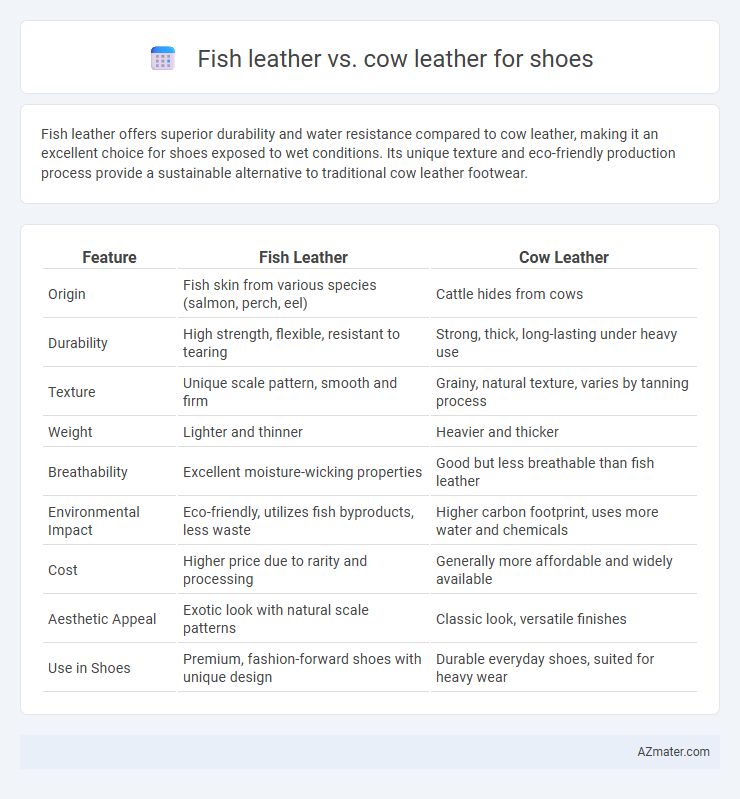Fish leather offers superior durability and water resistance compared to cow leather, making it an excellent choice for shoes exposed to wet conditions. Its unique texture and eco-friendly production process provide a sustainable alternative to traditional cow leather footwear.
Table of Comparison
| Feature | Fish Leather | Cow Leather |
|---|---|---|
| Origin | Fish skin from various species (salmon, perch, eel) | Cattle hides from cows |
| Durability | High strength, flexible, resistant to tearing | Strong, thick, long-lasting under heavy use |
| Texture | Unique scale pattern, smooth and firm | Grainy, natural texture, varies by tanning process |
| Weight | Lighter and thinner | Heavier and thicker |
| Breathability | Excellent moisture-wicking properties | Good but less breathable than fish leather |
| Environmental Impact | Eco-friendly, utilizes fish byproducts, less waste | Higher carbon footprint, uses more water and chemicals |
| Cost | Higher price due to rarity and processing | Generally more affordable and widely available |
| Aesthetic Appeal | Exotic look with natural scale patterns | Classic look, versatile finishes |
| Use in Shoes | Premium, fashion-forward shoes with unique design | Durable everyday shoes, suited for heavy wear |
Introduction to Fish Leather and Cow Leather
Fish leather, derived from species such as salmon, cod, and perch, offers a sustainable alternative to traditional cow leather, boasting a unique texture and high durability. Cow leather, sourced from cattle hides, remains the dominant material in shoe manufacturing due to its strength, flexibility, and long-lasting qualities. Both materials undergo tanning processes that enhance their natural properties, with fish leather gaining popularity for its eco-friendly attributes and distinctive scale patterns.
Origins and Production Processes
Fish leather originates primarily from salmon, cod, and perch, utilizing the skin byproduct of the fishing industry, which promotes sustainability through waste reduction. Its production involves careful tanning and drying techniques that maintain the skin's unique scale patterns and lightweight durability. Cow leather, sourced from cattle hides, undergoes extensive tanning processes for strength and flexibility, with origins rooted in traditional livestock farming and larger-scale industrial leather production.
Durability Comparison
Fish leather exhibits remarkable durability due to its unique fiber structure, which is more resistant to stretching and tearing compared to cow leather. Its high collagen density and natural moisture resistance make fish leather ideal for long-lasting shoes in wet environments. However, cow leather remains highly durable with superior abrasion resistance, making it preferable for heavy-duty footwear demanding extensive wear.
Environmental Impact
Fish leather production generates significantly less environmental pollution and water consumption compared to cow leather, making it a more sustainable option for footwear. The tanning process for fish leather often uses fewer chemicals and yields less harmful waste, reducing the ecological footprint. Choosing fish leather for shoes supports sustainable practices and helps decrease the overall impact of leather manufacturing on deforestation and greenhouse gas emissions.
Aesthetic Qualities and Texture
Fish leather for shoes offers a unique aesthetic with its distinctive scale patterns and natural iridescence, creating a visually striking and unconventional look compared to traditional cow leather. The texture of fish leather is generally smoother and more supple, providing a lightweight yet durable material that molds comfortably to the foot. Cow leather, by contrast, is prized for its uniform grain and classic matte finish, delivering a timeless, rugged appearance with a firmer texture often preferred for structured footwear.
Comfort and Breathability
Fish leather offers superior breathability compared to cow leather due to its natural porous structure, allowing better air circulation and moisture regulation inside shoes. The lightweight and flexible nature of fish leather enhances comfort by conforming closely to the foot's shape, reducing stiffness often found in traditional cow leather. Cow leather, while durable, tends to be thicker and less breathable, which can result in increased heat and moisture buildup, potentially compromising overall comfort during prolonged wear.
Cost and Market Availability
Fish leather offers a unique alternative to cow leather in shoe manufacturing, often costing 20-40% more due to specialized tanning processes and limited production scale. While cow leather dominates the global market with widespread availability and consistent supply chains, fish leather remains niche, primarily sourced from regions with strong fishing industries like Norway and Japan. The higher price and constrained availability of fish leather limit its use to premium or eco-conscious footwear brands seeking distinctive texture and sustainability credentials.
Ethical and Sustainability Considerations
Fish leather offers a more sustainable alternative to cow leather due to its lower environmental impact, as it utilizes byproducts from the fishing industry, reducing waste. The production of fish leather requires less water and emits fewer greenhouse gases compared to traditional cow leather tanning processes. Ethically, fish leather supports circular economy principles by repurposing materials that would otherwise be discarded, making it a favorable choice for eco-conscious footwear brands.
Popular Uses in Footwear Design
Fish leather offers a unique texture and high durability favored in niche and luxury footwear designs, particularly for creating statement shoes that emphasize sustainability and exotic appeal. Cow leather remains the dominant choice due to its versatility, strength, and ability to be treated for various finishes, making it ideal for everyday, formal, and casual shoe styles. Designers often select fish leather for limited-edition or artisanal footwear collections aiming to attract eco-conscious consumers and those seeking innovative materials.
Conclusion: Choosing the Right Leather for Shoes
Fish leather offers exceptional durability and a unique texture ideal for fashion-forward shoes, while cow leather remains the benchmark for versatility and long-lasting comfort. Selecting the right leather depends on desired characteristics such as sustainability, aesthetic appeal, and wear resistance. Fish leather suits eco-conscious consumers seeking distinct style, whereas cow leather is preferred for classic, reliable footwear performance.

Infographic: Fish leather vs Cow leather for Shoe
 azmater.com
azmater.com